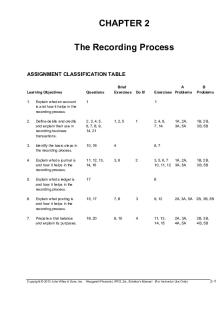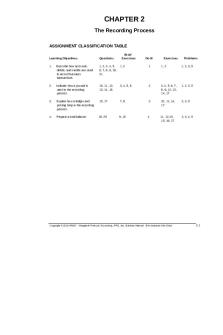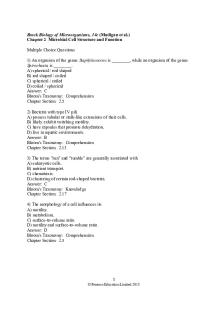Ch02 - Chapter 2 PDF

| Title | Ch02 - Chapter 2 |
|---|---|
| Course | Financial Accounting |
| Institution | Abu Dhabi University |
| Pages | 12 |
| File Size | 174 KB |
| File Type | |
| Total Downloads | 95 |
| Total Views | 159 |
Summary
Chapter 2...
Description
CHAPTER 2 The Recording Process LEARNING OBJECTIVES 1. EXPLAIN WHAT AN ACCOUNT IS AND HOW IT HELPS IN THE RECORDING PROCESS. 2. DEFINE DEBITS AND CREDITS AND EXPLAIN THEIR USE IN RECORDING BUSINESS TRANSACTIONS. 3. IDENTIFY THE BASIC STEPS IN THE RECORDING PROCESS. 4. EXPLAIN WHAT A JOURNAL IS AND HOW IT HELPS IN THE RECORDING PROCESS. 5. EXPLAIN WHAT A LEDGER IS AND HOW IT HELPS IN THE RECORDING PROCESS. 6. EXPLAIN WHAT POSTING IS AND HOW IT HELPS IN THE RECORDING PROCESS. 7. PREPARE A TRIAL BALANCE AND EXPLAIN ITS PURPOSES.
________________ Copyright © 2016 John Wiley & Sons, Inc. Weygandt Financial Accounting IFRS 3e Instructor•s Manual (For Instructor Use Only)
2-1
CHAPTER REVIEW The Account
1.
(L.O. 1) An account is an individual accounting record of increases and decreases in a specific asset, liability, or equity item.
2.
In its simplest form, an account consists of (a) the title of the account, (b) a left or debit side, and (c) a right or credit side. The alignment of these parts resembles the letter T, and therefore the account form is called a T-account.
Debits and Credits 3.
4. 5.
(L.O. 2) The terms debit and credit mean left and right, respectively. a. The act of entering an amount on the left side of an account is called debiting the account and making an entry on the right side is crediting the account. b. When the debit amounts exceed the credits, an account has a debit balance; when the reverse is true, the account has a credit balance. In a double-entry system, equal debits and credits are made in the accounts for each transaction. Thus, the total debits will always equal the total credits. The effects of debits and credits on assets and liabilities and the normal balances are: Accounts Assets Liabilities
Debits Increase Decrease
Credits Decrease Increase
Normal Balance Debit Credit
6.
Accounts are kept for each of the five subdivisions of equity: Share Capital—Ordinary, Retained Earnings, Dividends, Revenues, and Expenses.
7.
The effects of debits and credits on the equity accounts and the normal balances are: Accounts Share Capital—Ordinary Retained Earnings Dividends Revenues Expenses
8.
Debits Decrease Decrease Increase Decrease Increase
Credits Increase Increase Decrease Increase Decrease
Normal Balance Credit Credit Debit Credit Debit
The expanded basic equation is: Assets = Liabilities + Share Capital + Retained Earnings – Dividends + Revenues – Expenses
The Recording Process 9.
(L.O. 3) The basic steps in the recording process are: a. Analyze each transaction for its effect on the accounts. b. Enter the transaction information in a journal. c. Transfer the journal information to the appropriate accounts in the ledger.
________________ Copyright © 2016 John Wiley & Sons, Inc. Weygandt Financial Accounting IFRS 3e Instructor•s Manual (For Instructor Use Only)
2-2
The Journal 10.
(L.O. 4) Transactions are initially recorded in a journal. a. A journal is referred to as a book of original entry. b. A general journal is the most basic form of journal.
11.
The journal makes several significant contributions to the recording process: a. It discloses in one place the complete effect of a transaction. b. It provides a chronological record of transactions. c. It helps to prevent or locate errors because the debit and credit amounts for each entry can be readily compared.
12.
Entering transaction data in the journal is known as journalizing. When three or more accounts are required in one journal entry, the entry is known as a compound entry.
The Ledger 13.
(L.O. 5) The ledger is the entire group of accounts maintained by a company. It keeps in one place all the information about changes in account balances and it is a source of useful data for management.
14.
The standard form of a ledger account has three columns and the balance in the account is determined after each transaction.
15.
(L.O. 6) Posting is the procedure of transferring journal entries to the ledger accounts. The following steps are used in posting: a. In the ledger, enter in the appropriate columns of the account(s) debited the date, journal page, and debit amount. b. In the reference column of the journal, write the account number to which the debit amount was posted. c. Perform the same steps in a. and b. for the credit amount.
The Chart of Accounts 16.
A chart of accounts is a listing of the accounts and the account numbers which identify their location in the ledger. The numbering system usually starts with the statement of financial position accounts and follows with the income statement accounts.
________________ Copyright © 2016 John Wiley & Sons, Inc. Weygandt Financial Accounting IFRS 3e Instructor•s Manual (For Instructor Use Only)
2-3
The Basic Steps 17.
The basic steps in the recording process are illustrated as follows: Transaction
On September 4, Fesmire Inc. pays $3,000 cash to a creditor in full payment of the balance due.
Basic analysis The liability Accounts Payable is decreased $3,000, and the asset Cash is decreased $3,000. Debit-credit analysis
Journal entry
Posting
Debits decrease liabilities: debit Accounts Payable $3,000. Credits decrease assets: credit Cash $3,000.
Sept. 4 Accounts Payable Cash (Paid creditor in full) Cash Sept. 4
1 3,000
26 1
3,000 3,000
Accounts Payable Sept. 4 3,000
26
The Trial Balance 18.
(L.O. 7) A trial balance is a list of accounts and their balances at a given time. The primary purpose of the trial balance is to prove the mathematical equality of the debits and credits after posting.
19.
A trial balance does not prove that all transactions have been recorded or that the ledger is correct because the trial balance may still balance when a. a transaction is not journalized. b. a correct journal entry is not posted. c. an entry is posted twice. d. incorrect accounts are used in journalizing or posting. e. offsetting errors are made in recording the amount of a transaction.
________________ Copyright © 2016 John Wiley & Sons, Inc. Weygandt Financial Accounting IFRS 3e Instructor•s Manual (For Instructor Use Only)
2-4
LECTURE OUTLINE A.
The Account. An account is an accounting record of increases and decreases in a specific asset, liability, or equity item. An account consists of three parts: 1. A title. 2. A left or debit side. 3. A right or credit side.
B.
Debits and Credits. The terms debit and credit are directional signals: Debit indicates left, and credit indicates right. 1. Assets, dividends, and expenses are increased by debits and decreased by credits.
2. Liabilities, share capital—ordinary, retained earnings, and revenues are increased by credits and decreased by debits.
INVESTOR INSIGHT – Keeping Score The Brother Elephants (TW) baseball team probably has Admissions (ticket sales), Concessions, and Television and Radio Advertising accounts as its major revenue accounts. In addition the team probably has major expense accounts ________________ Copyright © 2016 John Wiley & Sons, Inc. Weygandt Financial Accounting IFRS 3e Instructor•s Manual (For Instructor Use Only)
2-5
that include Players• Salaries, Administrative Salaries, Travel, and Stadium Maintenance. Do you think that the Manchester United (GBR) football (soccer) club would be likely to have the same major revenue and expense accounts as Brother Elephants? Answer: Because their businesses are similar—professional sports—many of the revenue and expense accounts for these teams might be similar. C.
Steps in the Recording Process. Businesses use three basic steps in the recording process: 1. Analyze each transaction for its effects on the accounts. 2. Enter the transaction information in a journal. 3. Transfer the journal information to the appropriate accounts in the ledger.
D.
The General Journal/Journalizing. Entering transaction data in the general journal is called journalizing. The general journal: 1. Discloses in one place the complete effects of a transaction. 2. Provides a chronological record of transactions. 3. Helps to prevent or locate errors because the debit and credit amounts for each entry can be easily compared. 4. A simple journal entry involves only two accounts (one debit and one credit) whereas a compound journal entry involves three or more accounts.
________________ Copyright © 2016 John Wiley & Sons, Inc. Weygandt Financial Accounting IFRS 3e Instructor•s Manual (For Instructor Use Only)
2-6
E.
The Ledger. The ledger is the entire group of accounts maintained by a company. A general ledger contains all the assets, liabilities, and equity accounts. 1. The ledger provides information about changes in specific account balances for a company. 2. While the simple T-form is useful for illustration purposes, a three-column form of account (showing debit, credit and balance columns) is commonly used in practice.
ACCOUNTING ACROSS THE ORGANIZATION – What Would Sam Do? When Wal-Mart was just getting started, Sam Walton kept a little pigeonhole on the wall for cash receipts and paperwork of each store. He had a blue binder ledger book for each store. Why did Sam Walton keep separate pigeonholes and blue binders? Why bother to keep separate records for each store? Answer: Using separate pigeonholes and blue binders for each store enabled Walton to accumulate and track the performance of each individual store easily. Keeping separate records for each store provided Walton with more information about performance of individual stores and managers, and greater control. Walton would want and need the same advantages if he were starting his business today. The difference is that he might now use a computerized system for small businesses. F.
Posting/Chart of Accounts. 1. Posting is transferring journal entries to the ledger accounts.
________________ Copyright © 2016 John Wiley & Sons, Inc. Weygandt Financial Accounting IFRS 3e Instructor•s Manual (For Instructor Use Only)
2-7
2. Posting involves the following steps: a.
In the ledger, enter, in the appropriate columns of the account(s) debited, the date, journal page, and debit amount shown in the journal.
b.
In the reference column of the journal, write the account number to which the debit amount was posted.
c.
In the ledger, enter, in the appropriate columns of the account(s) credited, the date, journal page, and credit amount shown in the journal.
d.
In the reference column of the journal, write the account number to which the credit amount was posted.
3. A chart of accounts lists the accounts and the account numbers that identify their location in the ledger. Accounts are usually numbered starting with the statement of financial position accounts followed by income statement accounts.
G.
Trial Balance. A trial balance is a list of accounts and their balances at a given time. 1. Its primary purpose is to prove (check) that the debits equal the credits after posting. 2. It can be used by the company to uncover errors in journalizing and posting. 3. It is useful in preparing financial statements.
INVESTOR INSIGHT – Why Accuracy Matters Recently statistical and communication problems were to blame for a € 55.5 billion error in the accounts of Hypo Real Estate Holding (DEU). Since the bank had been previously taken over by the German government, the error had resulted in an overstatement of the federal debt of €55.5 billion. ________________ Copyright © 2016 John Wiley & Sons, Inc. Weygandt Financial Accounting IFRS 3e Instructor•s Manual (For Instructor Use Only)
2-8
In order for this company to prepare and issue financial statements, its accounting equation (debits and credits) must have been in balance at year-end. How could this error have occurred? Answer: A company•s accounting equation (its books) can be in balance yet its financial statements have errors or misstatements because of the following: entire transactions were not recorded; transactions were recorded at wrong amounts; transactions were recorded in the wrong accounts; transactions were recorded in the wrong accounting period. Audits of financial statements uncover some, but obviously not all, errors or misstatements.
________________ Copyright © 2016 John Wiley & Sons, Inc. Weygandt Financial Accounting IFRS 3e Instructor•s Manual (For Instructor Use Only)
2-9
20 MINUTE QUIZ Circle the correct answer. True/False 1.
Assets are increased by debits and liabilities are decreased by credits. True
2.
The Share Capital—Ordinary account is increased by credits. True
3.
False
When the columns of the trial balance equal each other, it proves no errors occurred in recording and posting. True
10.
False
In posting, one should enter “J2” in the Post. Ref. Column on page two of the journal. True
9.
False
Assets = liabilities + share capital + retained earnings – dividends + revenues – expenses is a correct form of the expanded basic accounting equation. True
8.
False
Transferring journal entries to the ledger accounts is called posting and should be performed in chronological order. True
7.
False
The basic steps in the recording process are (1) to analyze each transaction, (2) to enter the transaction in a journal, and (3) to transfer the journal entry to the appropriate ledger accounts. True
6.
False
The ledger is the entire group of accounts maintained by a company. True
5.
False
An account will have a credit balance if the total debit amounts exceed the total credit amounts. True
4.
False
False
The double-entry system is possible because all business transactions may be expressed in equal debit and credit entries. True
False
________________ Copyright © 2016 John Wiley & Sons, Inc. Weygandt Financial Accounting IFRS 3e Instructor•s Manual (For Instructor Use Only)
2-10
Multiple Choice 1.
Transactions are initially recorded in the a. general ledger. b. general journal. c. trial balance. d. balance sheet.
2.
The right side of an account is referred to as the a. footing. b. chart side. c. debit side. d. credit side.
3.
A purchase of office equipment for cash requires a credit to a. Equipment. b. Cash. c. Accounts Payable. d. Share Capital—Ordinary.
4.
The equality of the accounting equation can be proven by preparing a a. trial balance. b. journal. c. general ledger. d. T-account.
5.
Which of the following accounts would be increased with a debit? a. Interest Payable b. Share Capital—Ordinary c. Service Revenue d. Dividends
________________ Copyright © 2016 John Wiley & Sons, Inc. Weygandt Financial Accounting IFRS 3e Instructor•s Manual (For Instructor Use Only)
2-11
ANSWERS TO QUIZ True/False 1. 2. 3. 4. 5.
False True False True True
6. 7. 8. 9. 10.
True True False False True
Multiple Choice 1. 2. 3. 4. 5.
b. d. b. a. d.
________________ Copyright © 2016 John Wiley & Sons, Inc. Weygandt Financial Accounting IFRS 3e Instructor•s Manual (For Instructor Use Only)
2-12...
Similar Free PDFs

Ch02 - Chapter 2
- 12 Pages

Ch02 Testbank - Test Bank, Chapter 2
- 76 Pages

Ch02
- 66 Pages

Ch02
- 60 Pages

Ch02
- 18 Pages

Ch02 mcqChapter 2 test bank
- 5 Pages

Ch02 PPT
- 71 Pages

Ch02 Analyzing Transactions
- 64 Pages

HW Week2 Solution ch02
- 6 Pages

Ch02 Problem Solutions
- 20 Pages

ER8e SM Ch02 - Practice
- 6 Pages

Ch02 Surette IM students
- 17 Pages
Popular Institutions
- Tinajero National High School - Annex
- Politeknik Caltex Riau
- Yokohama City University
- SGT University
- University of Al-Qadisiyah
- Divine Word College of Vigan
- Techniek College Rotterdam
- Universidade de Santiago
- Universiti Teknologi MARA Cawangan Johor Kampus Pasir Gudang
- Poltekkes Kemenkes Yogyakarta
- Baguio City National High School
- Colegio san marcos
- preparatoria uno
- Centro de Bachillerato Tecnológico Industrial y de Servicios No. 107
- Dalian Maritime University
- Quang Trung Secondary School
- Colegio Tecnológico en Informática
- Corporación Regional de Educación Superior
- Grupo CEDVA
- Dar Al Uloom University
- Centro de Estudios Preuniversitarios de la Universidad Nacional de Ingeniería
- 上智大学
- Aakash International School, Nuna Majara
- San Felipe Neri Catholic School
- Kang Chiao International School - New Taipei City
- Misamis Occidental National High School
- Institución Educativa Escuela Normal Juan Ladrilleros
- Kolehiyo ng Pantukan
- Batanes State College
- Instituto Continental
- Sekolah Menengah Kejuruan Kesehatan Kaltara (Tarakan)
- Colegio de La Inmaculada Concepcion - Cebu



